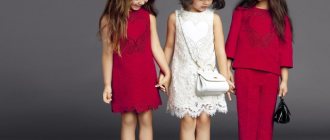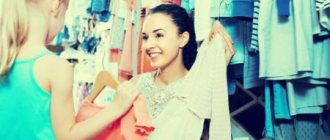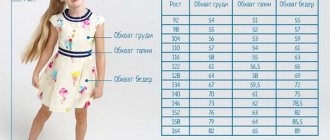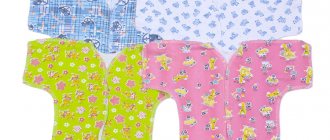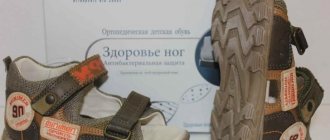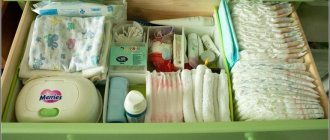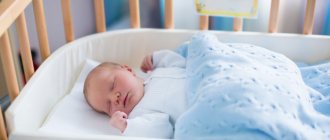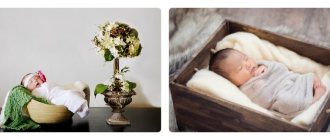What size clothes to buy for a newborn - going to the maternity hospital
When going to the maternity hospital, decide what clothes you will need for the baby, but until the child is born, it is impossible to know his height; an ultrasound shows only approximate data. But there are average parameters that will help you make a choice.
Basic clothing sizes for little ones:
- Size 50 clothing is the smallest size, intended for babies who were born much prematurely;
- size 56 - clothes are designed for children whose height is considered standard, 50–53 cm, it will last the baby for a month;
- 62 - suitable for babies over 1 month, but if you are expecting a large baby, then these clothes will suit him immediately after birth.
Since you don’t know whether your baby will be large or puny, purchase several products in sizes 56 and 62.
What do you need to buy for the maternity hospital?
We are sure that this list will help you not to forget anything and not to add unnecessary things:
- bodysuit;
- several cotton rompers and vests;
- light hats with ties;
- small blanket;
- envelope for discharge.
If the baby was born in winter, then the discharge kit differs significantly from the summer kit. Don’t forget to “warm” your baby before going outside for the first time.
Foreign clothing sizes
On the domestic market you can find clothes not only made in Russia, but also from foreign countries, which have their own system for determining clothing sizes.
It does not always coincide with the domestic line, so this fact should be taken into account when choosing. In Russia, it is customary to determine the size by the baby’s chest circumference. In Europe, growth is used for this.
On average, a newborn baby has a body length of 50 to 56 cm. This depends on the individual characteristics and term of the baby. It is useful to calculate the so-called Quetelet I index.
To do this, it is enough to divide the child’s weight by his height.
For example, weight is 3500 and height is 52 cm, then 3500/52 = 67.3. That is, we can conclude that the child’s size “fits” into WHO standards, which are intended for healthy children.
But here it is worth understanding that the Quetelet I index can only be used for children born on time. If a baby was born ahead of schedule, then its indicators will differ from the standards for some time.
In general, the average height for girls is considered to be 49 cm, and for boys 50 cm. On the market you can find clothes for babies produced in a variety of countries.
Sometimes on the label you can see even numbers from 18 to 22, and sometimes the marking consists of English letters. For example, S or M. For children under one year old, foreign manufacturers have created a special grid of sizes.
up to 3 months growth 55–64 3–6 months growth 64–68 6–9 months growth 68–72 9–12 months growth 72–74
See also: 8 growth and development spurts from birth to two years, how to recognize and how to help your child
It is important to make sure that the baby feels comfortable and that the clothes suit him in all respects. A wide variety of things can be useful for a baby: bodysuits, vests, rompers, hats, bonnets, socks and much more.
Russian clothing sizes for newborns by month - table
There are a lot of high-quality clothes on the market from domestic manufacturers, the size chart is quite simple, so as not to make a mistake with the choice, you need to measure the height and chest circumference of the child. On labels, sizes can be indicated by Russian or European values.
size table
| Age (months) | Bust (cm) | Height (cm) | European/Russian size |
| 0-1 | 37-40 | Up to 56 | 50-56/18 |
| 1-3 | 41-44 | 56-62 | 56-62/20 |
| 3-6 | 42-45 | 62-67 | 68/20 |
| 6-9 | 47-49 | 66-75 | 74/22 |
| 9-12 | 50 | 75-81 | 82/24 |
The metric parameters of European and Russian models are the same, but domestic products are more suitable for thin newborns, while clothes based on European patterns are suitable for plump children.
How much stock should I buy clothes with?
Rompers, slips, blouses, bodysuits - 1-2 sizes, children sometimes jump over a size. For warm clothes, buy 2 sizes larger at once so that you can wear lighter clothes underneath.
Sizes of baby vests for newborns
Baby onesies have always been essential clothing for babies. They are practical and warm, and they are also easy to put on a capricious child. However, choosing baby undershirts is not an easy task. You need to decide on the type of fastener, sleeve length, type of seams (external or internal). When choosing undershirts for a newborn baby, it is better to choose ones with an internal seam. A baby's soft skin can be damaged by tight stitches during movements.
The sizes of the vests are chosen solely according to the baby’s height. They can be free in width, thereby giving the child space to move. So, to measure the growth of a newborn, you need to place him on a flat surface. Let the baby calm down and relax. Hold this position for a few seconds and take several measurements. Select the average and compare your findings with the table below. You can also see the height measured by the doctor at the appointment. However, be careful, the baby will outgrow its size in 2-3 months.
Different manufacturers of vests use their own sizes. To make it easier to make a choice, we have compiled a table of average values for newborns and babies under 2 years old. All European manufacturers use almost the same size charts, so the results will vary minimally. Select the size of the vest for your child below.
Sizes of overalls for a newborn
Overalls are quite an expensive item that a child will quickly outgrow and no longer wear. We recommend buying it in advance and for growth, so that the baby is prepared for the winter period. Using the table below, you can quickly select the required size of overalls for a newborn for the winter. Measure your baby and compare the data obtained with the table.
How to choose clothes for children from foreign manufacturers
In addition to domestic products, there is a lot of Chinese and American clothing on the market; the sizing charts for such products differ from Russian standards.
Foreign clothing sizes for newborns by month - table
| Age (months) | America | China |
| newborns | 0/3 | 0 |
| 3 | 0/6 | 3 |
| 6 | 0/6 | 6 |
| 9 | 6/9 | 9 |
| 12 | S/M | 12 |
List of necessary basic things for the first half of the year
Clothing sizes for a newborn in the first three months are 56 and 62, closer to six months 68. The following things will be useful for the baby:
- three bodysuits of each size;
- cotton vests, rompers, 2-3 sets for each size;
- a light walking overall will come in handy if the period of growing up falls in the autumn or spring;
- if it’s winter outside, you’ll have to buy a warm winter walking suit and a fleece suit with a lining or velor;
- in the summer heat, the baby can be dressed easily, but the legs must be warm, socks will come in handy;
- 3-4 caps, a couple of hats for winter and spring;
- If parents do not plan to use diapers at home, then they should pay more attention to purchasing replacement onesies and reusable diapers.
The list can be expanded, the range of children's clothing is huge and the tasks of parents are different, as well as the time of year in which the baby is born.
How to choose hats and socks
Babies require thin, demi-season and warm hats; to determine the correct size, you just need to measure the head circumference.
Selecting the cap size:
- 0-3 months (35-40);
- 3-6 (44-46);
- 6-9 (46-47);
- 9-12 (47).
Thin hats should be taken exactly in accordance with the circumference, warm ones - one size larger. Boys need larger sizes than girls.
To select socks, you need to measure the length of the foot, usually 8-9 cm, the optimal size of products for babies is 0, or 0-3, there may be a designation of 10 on Russian goods.
How much to buy clothes with?
If a newborn constantly wears disposable diapers, there is no point in purchasing a large amount of clothing. For the first three months of life, the baby will need:
- Winter envelope for walks – 1 pc.;
- Woolen hat for winter-autumn – 1 pc.;
- Calico cap 3-4 pcs. and 2-3 pcs. flannel;
- Calico and flannel diapers - 15-20 pcs.;
- Baby vests (chintz, flannel) – 10 pcs.;
- Flannel blouses with fasteners – 5-6 pcs.
Why might a child under one year old have bad urine?
If desired, you can also purchase several children's bodysuits and overalls made of cotton fabric. Which color to choose depends on the gender of the child and the tastes of the parents. Also, young parents usually buy two or three sets of bedding for their crib.
Attention! You should not buy too many products of the same size and type, because children under one year old develop very quickly. It is known that in the first three months the baby grows by about 10 cm. Then the increase in weight and height slows down a little. From six months to one year, on average, a child gains 300-500 grams. and grows by 2-2.5 cm monthly.
Choosing underwear and rompers
When choosing such products, you need to take into account 3 indicators - age, waist size and hip circumference, otherwise the child will be uncomfortable in them.
size table
| Size | Height (cm) | Waist (cm) | Hips (cm) | Age (months) |
| 18 | Up to 56 | 40 | 42 | Up to 1.5 |
| 20 | 60-68 | 44 | 46 | 2-6 |
| 22 | 74 | 45 | 50 | 6-9 |
| 24 | 80 | 48 | 54 | 9-12 |
Sizes of caps for newborns and children's caps
The sizes of caps for newborns and hats are determined by the length of the head circumference in centimeters. You need to measure your head exactly along the eyebrows, above the ears and then to the back of the head. We measure a newborn when he is lying down, then lower the centimeter vertically from the eyebrows to the back of the head. If the newborn is already holding his head, it is better to measure the head circumference while someone is holding him. If the baby is already sitting, measure while sitting. Then we clasp the head with a centimeter strictly horizontally.
There are a variety of sizes of caps for newborns and children's hats: letters and numbers, single and double, according to size grids every 1, 2 or 4 cm. Most manufacturers sew caps and hats according to size grids with double sizes 36-38, 40-42 or 38-40, 42-44 or according to the size chart after 2 cm, for example, 36, 38, 40, 42. Sometimes the height of the newborn is indicated simultaneously with the volume of the head, for example, 36/56, 40/62, 44/68, or the age of the child.
For the sake of safety and health, we recommend wearing bonnets and caps, especially for newborns, that fit properly.
| Size chart of hats and bonnets for boys |
| Boys age | 0 months | 1 month | 2 months | 3 months | 6 months |
| Average head circumference | 34-39 | 37-41 | 39-43 | 41-45 | 43-47 |
| Boys age | 9 months | 1 year | 1.5 years | 2 years |
| Average head circumference | 45-48 | 47-49 | 48-50 | 48-51 |
| Size chart of hats and bonnets for girls |
| Girls age | 0 months | 1 month | 2 months | 3 months | 6 months |
| The average size | 32-38 | 35-40 | 37-42 | 39-44 | 41-46 |
| Girls age | 9 months | 1 year | 1.5 years | 2 years |
| The average size | 43-47 | 45-48 | 47-49 | 48-50 |
If you come across a letter designation for the size of a cap for a newborn or a children's hat, then the table below will help you determine the appropriate size:
| Size | XXS | XS | S | M |
| Head circumference | 40-43 | 44-46 | 47-49 | 50-52 |
Useful tips
Do not try to buy all the clothes for your baby in the store, to avoid unnecessary and unnecessary expenses, make a list, take a limited amount, preferably in cash, the money from the card disappears very unnoticed.
How much clothing do you need for the first time:
- slips and caps – 3-5 pcs.;
- light and warm bodysuits – 2-4 pcs.;
- sliders – 4-6 pcs.;
- socks – 2-3 pairs;
- hats – 2-3 pcs.;
- insulated and demi-season overalls, hat and socks – 1 pc.;
- outfit for special occasions – 1 pc.
The advisability of using anti-scratch pads is questioned by many doctors - even in products made from thin materials, hands sweat, diaper rash may appear between the fingers, this is due to imperfect thermoregulation in the child’s body.
It is better to cut your baby’s nails regularly and use protective gloves only during nighttime sleep.
Children's models, like adults, can be small or full-size, so if your child fits size 62 from one manufacturer, it is not a fact that products with the same markings from another company will fit him.
If you want to update your baby's wardrobe, measure the length of the sleeve, the inner and outer seam of the rompers, and the width of the clothes that currently fit your baby.
General useful recommendations
Finally, we will give general recommendations to all parents who want to learn how to choose the right things for children under the age of one year:
- When choosing any item for your little daughter or son, take into account not his age, but his body parameters. All babies are different: some are born large and grow rapidly, while others are born miniature and do not gain weight and height so quickly.
- Every large company that sews clothes for children has a size chart that indicates the exact parameters and the corresponding sizes. You can find it either on the label or on the manufacturer’s official website.
- You should not buy a lot of things for a baby under three months. From the moment of birth to this age, the baby will grow by an average of 10-12 centimeters. That is, what was purchased in the size for a newborn will definitely become small.
- Since growth is very active in the first months of life, two sizes can change before the age of three months. Further changes occur less frequently: approximately one size interval per three months.
- The first year of life passes very quickly, and children grow especially rapidly during this period of life. Therefore, buying too many things is simply pointless. Purchase several sets for home and going out, taking into account the need to change and wash dirty items.
The recommendations in this article will definitely help you choose the right size items for your baby. Good luck with your choice!
What else should you consider when choosing clothes?
When choosing clothes for a child, it is important not only to determine the correct size, but also to select products that are high-quality, comfortable and safe.
Rules for choosing clothes:
- Sliders - come in high and standard fit, with closed heels or cuffs at the bottom. The best option for newborns is rompers with a high waist, closed heels, and external seams; when the baby starts crawling, models with straps will be the most comfortable.
- Vests - come with ties, various fasteners, with long and short sleeves. The most convenient option is buttons or buttons with an asymmetrical or lateral arrangement; choose the material and sleeve length in accordance with the season. Baby vests with ties are the most inconvenient; the strings constantly get untied or tangled.
- Bodysuits are the most comfortable type of children's clothing, they combine shorts and a blouse, do not slip, the optimal location of the fasteners allows you to quickly change the diaper.
Clothes for children should not be bright colors - excessive dye content in fabrics will not benefit a newborn, and products made from synthetics are also not suitable.
Snaps and buttons should not be located on the back; all fasteners should be small with smooth, non-sharp edges. Products with zippers are not suitable for children. The seams are external, even, without protruding threads; the elastic bands should not be too tight.
Types of children's clothing
How often to change a newborn's diaper
If the baby was born in the summer, the first three months are enough for him with diapers and vests. However, for walks and doctor visits, more comfortable, functional clothing is required. The baby will need:
- Envelope overalls for walking in a stroller;
- Baby vests. They are usually worn by children under six months old. When the child learns to sit independently, they are replaced with T-shirts or T-shirts with short sleeves;
- Bodysuit. This is comfortable clothing for walking in the summer and for routine visits to the doctor;
- Sliders. They are needed when the baby begins to actively move. However, if it is cold at home or outside, rompers can also be put on a newborn, under the diaper in which he is wrapped.
Hats are an integral part of a child's wardrobe. For children under one year old, this is a thin cap made of cotton fabric (worn after bathing), a thicker flannel cap (worn on a walk and at home, if it is cold in the apartment), a woolen hat for the street.
In winter, the baby wears booties or warm woolen socks on his rompers. It is strictly forbidden to wear them on bare legs, because sensitive children's skin may experience severe discomfort from direct contact with fur.
Selection of things in winter and summer
In the summer, children under three months old wear a baby vest and a light cotton cap, and the baby is wrapped in a diaper. In hot weather, you can do without sliders. Therefore, if the baby was born in the warm season, he will need diapers, baby vests and two or three caps for the summer. You don’t have to buy an envelope for a walk, because in the stroller the baby is still covered with a blanket.
A “winter” newborn will definitely need warm overalls and a woolen hat. You should also choose appropriately sized flannel blouses with rivets and insulated rompers. In addition to calico diapers, you will need thicker ones.
The baby should feel comfortable in his suit
Determining the size of gloves according to the child's age
To quickly determine the required parameter for gloves made in European countries, the age of the baby will help. Typically, the average child who is under two years old needs size 1; for a child under four years old - the second; up to six years old - third, up to eight - fourth, and the like. In this case, we are talking about a standard that should be followed. Below is a table of sizes for children's mittens.
| Child's age | up to 6 months | 6-12 months | 1-2 years old | 3-4 years old | 4-6 years | 7-8 years | 9-10 years | 11-12 years old |
| International size | — | 0 | 1 | 2 | 3 | 4 | 5 | 6 |
| Domestic size | 10 | 11 | 12 | 13 | 14 | 15 | 16 | 17 |
Baby's first hat
The first hat a child tries on is a cap. It is sewn from cotton and other natural materials that:
· allow air to pass through,
absorb moisture
· keep warm in the cool season,
· do not allow to freeze.
Models for autumn and winter are made from fabrics containing a small percentage of wool. Sometimes manufacturers add synthetic fibers that help the product retain its shape after washing.
When preparing for autumn or winter discharge, you need to take care of the warmth and comfort of the baby. For this purpose, it is better to choose a warm knitted hat. If parents have organized a photo shoot in the “new born” style, hats with funny animal ears, as well as headbands with appliqué, will come in handy. Decorative models should be made of hypoallergenic materials, and their elasticity should be sufficient so as not to squeeze the baby’s head.
A hat is needed not only for warmth and comfort. She protects the fontanel, which closes closer to the year. Based on his condition, pediatricians assess the state of health and the pace of development of the child.
Features of children's hats
When choosing a hat for a newborn, first of all, pay attention to the design and packaging. It should not contain:
· labels,
· rough seams,
· buttons and other fasteners.
If possible, small decor should be removed or ensure its safety. The hat should not rub, injure the baby’s delicate skin or cause him discomfort. To do this, it is sewn so that the seams are located on the outside.
Parents should not buy hats with ties or clasps at the back. In the first months after birth, children mostly sleep during walks. Any elements located in the area of the crown or back of the head will put pressure on the scalp and cause discomfort. The same goes for appliques, bows, patterns and rhinestones. All this decor is needed primarily by parents, but it only causes discomfort for the baby. Its presence or absence on clothing does not indicate its quality.
Products made from natural wool usually tickle and irritate delicate skin, so it is recommended to wear a thin cotton cap underneath. In any case, it is preferable that the hat be made from natural material that allows the skin to breathe and is soft and has pleasant tactile properties. A small content of synthetic fibers improves its elasticity and increases resistance to deformation (especially after washing).
A hat for a baby should have the simplest possible design. This is the only way it will not restrict his movements and interfere with the normal development of the skull. Parents don't need to buy a lot of hats. In the first months, children grow quickly, so 2-3 pieces will be enough.
The fastening mechanism is usually an elastic band sewn along the edge of the product or ties. The first option is preferable. If the cap is selected according to the circumference of the head and does not squeeze the skin, it will not slide down over the eyes as soon as the child begins to act up and move actively.
Recommendations for choosing a hat for a newborn
Before choosing a hat for a newborn, parents need to master the principles of creating a wardrobe for walking. To avoid overheating and freezing, pediatricians recommend dressing your child according to the weather. After birth, thermoregulation mechanisms are not yet fully formed, so the baby reacts differently to decreases and increases in temperature: where adults are usually cold, he may be comfortable, but where it is warm, he may be too hot. If he sweats in a warm hat, it is better to replace it with a thin one. Otherwise, any gust of wind or drop in temperature will cause hypothermia.
Another rule: during the first months of life, the child must wear a hat while walking. In summer, it can be replaced with a Panama hat, which will protect the skin and eyes from direct sunlight.
Features of choosing clothes for newborns
When you go shopping, be prepared that you will want to buy half of the things you like at once. Don’t give in to emotions, otherwise you will later rack your brains over what to do with a bunch of unnecessary and uncomfortable, but completely new children’s clothes.
Please adhere to the following rules.
- It is advisable to buy clothes for a newborn, sewn with the seams facing out. Such models do not harm the delicate skin of children.
- Avoid lightning! Better buy things with buttons.
- Choose things only from natural fabrics (cotton, linen).
- You should not buy warm clothes in the same size as everything else. It is better to buy overalls 1-2 sizes larger.
- Print and take the size chart for newborns with you to the store.
- Please remember that clothing with the same markings may differ significantly from each other. If size 56 of newborn clothes from one manufacturer is just right for your baby, then it is not a fact that clothes from another manufacturer of the same size will suit him. For example, things run small, and the British brand NEXT produces things a little larger than indicated on the label.
- Don't buy a lot of clothes at once. First, test 1-2 things and decide what is more convenient for you (type of fastener, style, brand, model).
How to choose a cap
Since the cap is a lightweight headdress, often worn under other hats, it does not have warming functions and cannot be changed depending on the time of year or room temperature.
But baby hats are sold for different occasions. Elegant, uniquely decorated for girls and boys, summer and insulated versions are available. They are sewn from different materials, according to different patterns, different styles.
Material
For hats in the first months of a child’s life, only natural fabrics are used. Batiste, linen, flannel, cotton wool, satin, satin, muslin, nansook, knitwear or fine wool, but generally cotton fabrics are best suited for children's clothing (including hats).
We recommend reading: What is the normal head circumference for a newborn?
Natural cotton fabrics are soft, hygroscopic, warm, with a smooth surface. When purchasing a cotton cap, consider shrinkage when washed in hot water.
Linen fabrics are more hygroscopic than cotton fabrics; they adhere pleasantly to the skin. It is better to buy a linen hat for the hot season.
For the cold season, buy a wool hat. The soft, fine wool is lightweight and breathable.
It is advisable that the fabric be without a pattern, or that the pattern has fewer bright colors. Choose fabrics for children's caps that will not cause allergies in your baby.
Cut
Children's caps are sewn ordinary with a visor, plain or with colored inserts, with lace or bows. Hats for boys are chosen in a more discreet style, and for girls - the most elegant ones.
The styles of the baby's first headdress have evolved over the centuries: with an occipital insert, without an insert, and one-piece.
